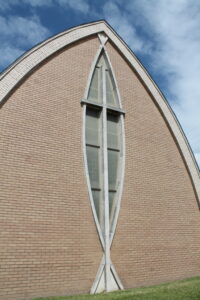History of the First Christian Church in Sulphur Springs

The historical marker outside the First Christian Church celebrates its history as one of the early congregations in Hopkins County. The recognizable “fish” stained glass art, which adorns the Davis-street facing facade of the First Christian Church, was constructed in 1962.
[adning id=”33097″]
In the 1850s, the town known as The Sulphur Springs was just beginning to coalesce. It was what would become Hopkins County’s third town, after Sulphur Bluff and Tarrant. Early pioneer life had religion as one of its pillars, and residents of the new town would meet at homes and vacant stores to study the gospel.
 In 1870, Revered Charles Carlton and Revered J.M. Baird organized one of the city’s first full-time congregations, which became known as the First Christian Church. After approximately twenty years of meeting, the group had about twenty devoted members.
In 1870, Revered Charles Carlton and Revered J.M. Baird organized one of the city’s first full-time congregations, which became known as the First Christian Church. After approximately twenty years of meeting, the group had about twenty devoted members.
In 1884 the congregation paired with the Baptists, worshipping on alternating Sundays, and thereby were able to have enough members to construct a building for themselves. They purchased a lot at Jackson and Hinnant for $600, according to deed records. Each of the congregations was entitled to one half of the property. However, by 1871 the congregation was outgrowing its bounds, and sold their half of the property to the Baptists in search of a place all their own.
In 1887 they purchased land on Van Sickle and North Davis streets near Magnolia and Connally. This lot was much smaller, and only cost the church $187.50. They built a Gothic-style chapel with steep roof, tall, arched windows, a central spire and a bell tower. There was no electricity at the time, so the cupolas held kerosene lamps.
In 1891 the church’s ladies aid society raised funds to purchase more land for the church, raising $2500 and purchasing two additional lots to the south. However, in 1912 the lots were purchased to build the new post office, fetching a price of $1500 each.
In 1914 they made this structure more permanent by constructing it out of white brick. By 1938 the church was bursting at the seams and required expansion, so the church added what was termed the Educational Building for youth services. Yet by 1954, the Educational Building needed replacement and another round of expansion due to wear and tear and a growing number of children who needed services.
[adning id=”33207″]
The church began its fundraising efforts hoping to bring in $17,000, but instead its generous patrons came up with $41,000. The two-story brick building they erected, with nine classrooms, a kitchen, a library and oak finishes, still stands today. 
In 1962 the church replaced the sanctuary portion of the structure entirely. The original 1914 sanctuary had stood in its place, yet what replaced it is the landmark many recognize in downtown Sulphur Springs today. The stained glass “fish,” on North Davis street specifically, stands out among Sulphur Springs churches as harbinger of the mod era in which the sanctuary was built.
“Buildings do not a church history make,” wrote First Christian Church historian Sidney Brice. “It is more the essence of the history of the church.” In its nearly 150 years as a congregation, the First Christian Church has gone through four full iterations of church buildings, not counting the different homes and storefronts they gathered in during the early days of Hopkins County.
 When the light streams in through the First Christian Church foyer and hits the stained glass fish just right, perhaps its former congregation can reflect that although times, buildings and architectural styles change, they may not always be together in the building, but they will always be the First Christian Church.
When the light streams in through the First Christian Church foyer and hits the stained glass fish just right, perhaps its former congregation can reflect that although times, buildings and architectural styles change, they may not always be together in the building, but they will always be the First Christian Church.
By Taylor Nye
[adning id=”33207″]













